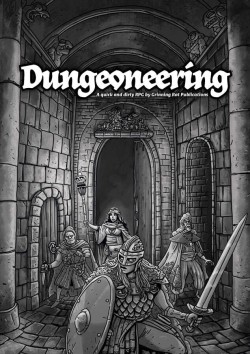Dungeoneering
 |
DUNGEONEERING is a quick-and-dirty tabletop role-playing game where players explore dungeons¸ gather treasure¸ and fight monsters. Game Masters are encouraged to use the sample dungeon within¸ or generate their own with the creation tools¸ to facilitate these dangerous delves.
There are few encounters in the tabletop role-playing game space so maligned by modern game design as the dungeon crawl.
Conflated with glacial pacing¸ tedious sense checks with arbitrary results¸ and senseless bookkeeping that does nothing to progress gameplay¸ dungeon crawls become a dreaded encounter for Game Masters and players alike.
This zine seeks to remedy that.
Players & Their Roles
In DUNGEONEERING¸ players choose one of four roles (the Warrior¸ the Magician¸ the Thief¸ or the Prophet) and roll up their statistics (Might¸ Intellect¸ Agility¸ and Favor)¸ along with their hit points. Once the preliminary character building is complete¸ the players will have to rely on their own cunning to get through the dungeon alive.
Each role has their own special feature that only they can use:
The mighty Warrior can attack and carry more than any other character¸ at the risk of overextending themselves. The intelligent Magician can cast spells from their grimoire or from scrolls found in the dungeon¸ at the risk of misfires and anomalies. The agile Thief can pick locks and disable or enable traps¸ at the risk of either backfiring. The favored Prophet can call upon their deity for assistance through prayer¸ at the risk of becoming forsaken. Game Masters & Their Domains
Game Masters¸ meanwhile¸ will be busy dressing the dungeon with all manner of monsters¸ treasures¸ and traps to beguile the players and disarm the characters.
The GM may create their own sprawling underworlds or utilize the dungeon generation tools in the zine¸ drawing from six unique locales (Forest¸ Desert¸ Water¸ Fire¸ Ice¸ and Sky). An additional sample dungeon is included in the zine for those who want to run a game as soon as possible.
The generation tools go further and offer sample intersections¸ hallways¸ dead-ends¸ pits¸ stairs¸ and lairs (among many others) to place in your locale. Each have their own unique tables for even more specificity. GMs then add life to these rooms with interesting encounters built from the robust encounter tables.
What Do I Need To Play?
All you need to get started in DUNGEONEERING are the rules¸ paper¸ pencil¸ and a six-sided die (probably a few six-sided dice¸ to be safe). The dungeon generation tools and sample dungeon certainly allow a group to hit the ground running¸ but are not required for play if a GM wants to come up with a dungeon on their own.
DUNGEONEERING is a quick-and-dirty tabletop role-playing game where players explore dungeons¸ gather treasure¸ and fight monsters. Game Masters are encouraged to use the sample dungeon within¸ or generate their own with the creation tools¸ to facilitate these dangerous delves.
There are few encounters in the tabletop role-playing game space so maligned by modern game design as the dungeon crawl.
Conflated with glacial pacing¸ tedious sense checks with arbitrary results¸ and senseless bookkeeping that does nothing to progress gameplay¸ dungeon crawls become a dreaded encounter for Game Masters and players alike.
This zine seeks to remedy that.
Players & Their Roles
In DUNGEONEERING ¸ players choose one of four roles (the Warrior ¸ the Magician ¸ the Thief¸ or the Prophet) and roll up their statistics ( Might ¸ Intellect ¸ Agility ¸ and Favor )¸ along with their hit points. Once the preliminary character building is complete¸ the players will have to rely on their own cunning to get through the dungeon alive.
Each role has their own special feature that only they can use:
The mighty Warrior can attack and carry more than any other character¸ at the risk of overextending themselves. The intelligent Magician can cast spells from their grimoire or from scrolls found in the dungeon¸ at the risk of misfires and anomalies. The agile Thief can pick locks and disable or enable traps¸ at the risk of either backfiring. The favored Prophet can call upon their deity for assistance through prayer¸ at the risk of becoming forsaken. Game Masters & Their Domains
Game Masters¸ meanwhile¸ will be busy dressing the dungeon with all manner of monsters¸ treasures¸ and traps to beguile the players and disarm the characters.
The GM may create their own sprawling underworlds or utilize the dungeon generation tools in the zine¸ drawing from six unique locales ( Forest ¸ Desert ¸ Water ¸ Fire ¸ Ice ¸ and Sky ). An additional sample dungeon is included in the zine for those who want to run a game as soon as possible.
The generation tools go further and offer sample intersections¸ hallways¸ dead-ends¸ pits¸ stairs¸ and lairs ( among many others ) to place in your locale. Each have their own unique tables for even more specificity. GMs then add life to these rooms with interesting encounters built from the robust encounter tables.
What Do I Need To Play?
All you need to get started in DUNGEONEERING are the rules¸ paper¸ pencil¸ and a six-sided die ( probably a few six-sided dice¸ to be safe ). The dungeon generation tools and sample dungeon certainly allow a group to hit the ground running¸ but are not required for play if a GM wants to come up with a dungeon on their own.